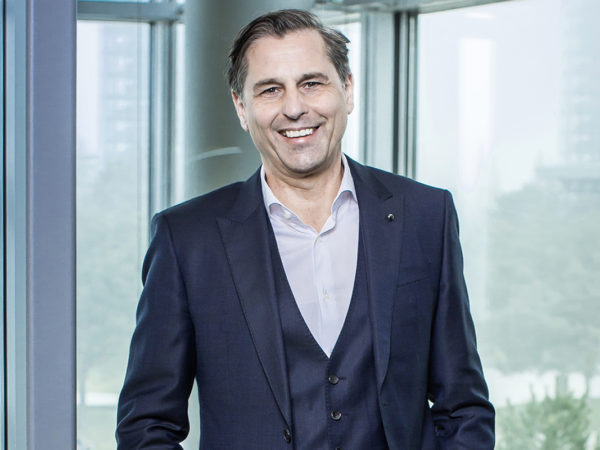From Gigafactory
to Giga-Business
Electric cars are only as good as their batteries — one of the most essential and expensive components. The producers of these batteries need to master the technologies and offer competitive prices if they are to succeed. The battery experts at Porsche Consulting know the means by which large numbers of the coveted energy storage devices can be produced — at half the price.
06/2021

Ever more people are choosing to buy electric cars, also thanks to additional incentives for the purchase of new vehicles. It is now time for the industry to act and to establish battery factories rapidly in many parts of the world, including Europe. Known as gigafactories, they require huge levels of investment. But how and where can they become profitable businesses? A team of experts from Porsche Consulting has compared the associated opportunities and risks. Its comprehensive analysis focuses on modern battery technologies, efficient production processes, and the right sites and scaling for sustainable production in Europe.
EU countries are focusing on electromobility
Batteries play the same role in electric cars as engines do in conventional cars. They are of crucial importance for both the range and the charging speed. In the year 2021 they account for up to 40 percent of the overall cost of the new car. This makes electric mobility comparatively expensive. Their size, which is directly related to the range, is also an important factor in the decision to purchase an electric car. Nevertheless, the European Union (EU) saw a record number of newly registered electric cars in 2020, as reported by the European Automobile Manufacturers’ Association (ACEA). Premiums are still on offer to attract new customers because EU countries are placing a special emphasis on electric mobility in their efforts to meet the European Green Deal’s climate goals specified in late 2019.
Electric cars generally have battery sizes of 50 to 100 kilowatt-hours. By 2030, battery production capacities will have to exceed 1,000 gigawatt-hours to meet the needs of European carmakers. The industry, therefore, faces the dual challenge of reducing its costs while building large-scale battery factories in Europe. These gigafactories will have to operate economically and sustainably. That is the only way to ensure sufficient availability of electric cars in every price class.
By 2030, Europe alone will need twenty Gigafactories to meet local needs.
“Worldwide demand for traction batteries is likely to increase more than tenfold by 2030,” says Frank Seuster, Partner for Product and Technology at Porsche Consulting, in explaining the calculations by his team of experts. “By 2030, Europe alone will need twenty gigafactories to meet local needs.” Which battery technologies are produced, which production processes are used, and which site locations are chosen will be crucial factors for the business success of these companies and their investors. According to Seuster, more than 50 billion euros will need to be invested Europe-wide by 2030 for battery cell production alone.
Choosing the right battery technology
From the customer’s perspective, electric cars have to perform well compared to conventional car models with combustion engines. Many electric cars offer advantages in terms of acceleration and driving comfort. However, most customers are currently interested primarily in being able to drive long distances without breaks, i.e., in having to stop less often at charging stations. One solution is to have more powerful batteries with higher energy densities. A battery of the same dimensions would then have a greater range. Development work is therefore concentrating on increasing the energy but not the space. On top of that, batteries have to cost less. Both of these goals can be met with the help of technological advances.
Producers and suppliers are therefore devoting intensive efforts to improving extant lithium-ion technologies. Over the past two decades, they have managed to lower battery costs by around 80 percent. Step-by-step replacement of expensive cobalt with nickel has played a prominent role here. Both of these metals bind lithium in the layered structure of cathodes. The higher percentage of nickel has also helped to triple the energy density—which is responsible for the battery’s size and weight—within the same period of time. To further increase the range, a number of producers are studying how to enhance the chemistry of nickel-rich cells, with a special emphasis on safety and life span.
For short-distance travel, lithium iron phosphate cells can accelerate the transition to electric mobility.
“Energy densities can be further improved by raising the percentage of silicon in the anode. Research is focusing on ensuring a sufficiently long service life,” says Lukas Mauler, Manager at Porsche Consulting and an expert in the field of battery technologies and the markets for these high-priority products. Mauler notes that depending on the vehicle segment, it can also make sense to use other chemical compositions of lithium-ion cells. “For short-distance travel, lithium iron phosphate cells can accelerate the transition to electric mobility because the cost benefits of this technology appeal to car buyers with a strong interest in price,” he suggests, adding that long service lives are also attractive for commercial vehicles and purposes. Prospective Gigafactory builders should therefore choose the right future-oriented technology for the vehicle sector they expect to serve. Mauler notes it is essential for the product range to be flexible in order to address dynamic developments on the market. This also applies to the post-lithium-ion technologies of the future such as solid-state batteries. Production of this technology is expected to start within the next ten years.
How battery costs can be cut in half
Efficient and flexible production processes
The production spaces at Gigafactories—where electrodes are manufactured in multiple steps, mounted in cell form, and activated for later use—are undergoing dynamic development on a continuous basis. Considerable capital is needed to set up this type of factory: between two and four billion euros depending on anticipated annual production figures. According to the calculations in Porsche Consulting’s technology-based cost model, the highest single investments go to machinery and plants and account for around 10 percent of battery costs.
Operations at existing Gigafactories have been made more economical by speeding up processes and thereby lowering production costs. Additional effects are expected in the near future. New process technologies like dry-coating the electrodes promise further reductions in cost. “Eliminating solvents that harm the environment means you can also eliminate the need for costly drying periods that require high levels of energy,” says Dr. Fabian Duffner, Senior Manager at Porsche Consulting and the expert team’s specialist in production and costs. “This has a valuable double effect because you not only lower costs but also improve vehicle life-cycle assessments.”
Eliminating solvents that harm the environment means you can also eliminate the need for costly drying periods that require high levels of energy.
All manufacturing processes can be made more efficient and sustainable by avoiding or minimizing rejects. That also applies to the defect rate in battery factories. The solution consists of early warning systems that prevent defects from arising in the first place. Smart factory strategies that digitally connect all the machines and plants can help by enabling reliable prognostics. If producers incorporate these types of enhanced processes in the initial planning stages for their Gigafactories and combine them with innovations, they can help achieve affordable and environmentally-friendly electric mobility, reduce investment costs, and remain competitive over the long term. Porsche Consulting advised LG Chem, a South Korean battery maker and leader on the global market, on setting up its battery factory in Poland. Kyong Deuk Jeong, President of LG Chem Wrocław Energy, reported that “with the maintenance approach of Porsche Consulting, we are able to increase our output by 14 percent.”


Advantages and disadvantages of individual sites
The cell factories of the future will be among the largest production buildings in the world. The respective companies favor different sites for their investments. Northvolt has picked Sweden, Volkswagen has chosen Germany, and LG Chem has opted for Poland. Proximity to the automotive production facilities scattered across the EU is not the only factor to play a role. Others include the availability of skilled workers, the anticipated costs for energy and personnel, and the availability of renewable “green” power.
The comprehensive site comparison by Porsche Consulting has shown that some EU countries do especially well in meeting two of these criteria but no single country currently leads in all three. Manufacturers, therefore, select their sites to fit their market positions and strategies. “Newcomers prefer countries with a sufficient pool of battery experts in order to catch up in terms of expertise, whereas established market leaders opt-in part for cost benefits in wages and energy,” says Dr. Fabian Duffner. Cell makers are also using renewable power for their Gigafactories as a way to stand out, which gives them a further competitive advantage. “In addition to zero-emission driving, customers and the public in general care about the resources consumed in their vehicle’s production process and batteries make up a large share of that,” explains Dr. Duffner.


Battery production in Europe:
Which country has which capabilities?
Porsche Consulting has studied the suitability of countries in the European Union as locations for battery factories. Its analysis considers a number of different factors for the three categories of sustainability, expertise and cost: country-specific research activities, availability of relevant skilled workers, investment in education and training, country-specific energy, wage, and construction costs, and the percentage of renewable energy in gross electricity consumption. Some countries combine advantages in two categories, and some lead in one. At present no single EU country stands out in all three.
Forecasting models help set the course
Can Gigafactories fulfill their crucial role in achieving climate-neutral mobility and thereby soon become giga-businesses? Outstanding opportunities do in fact await farsighted and strategically minded investors and manufacturers. “Dynamic developments in battery technology are generating enormous market potential on a trans-industry basis. Not only the automotive industry but also and especially the machinery and plant engineering sectors can benefit from entirely new possibilities,” says expert Lukas Mauler. In order to assess innovations on an overall basis, the Porsche consultants collaborate with a network of industry experts and researchers. Together the specialists use reliable forecasting models developed specifically for this purpose in order to evaluate market potential. “If the industry chooses the right course now in building battery factories, cars with electric drives will cost less than those with combustion engines by 2025,” predicts Mauler on the basis of his latest calculations.

